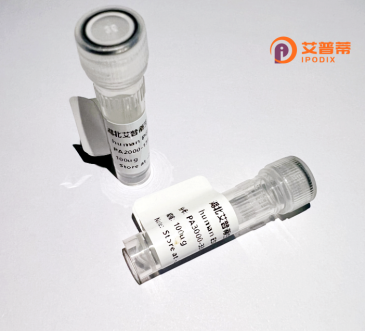
| 纯度 | >90%SDS-PAGE. |
| 种属 | Human |
| 靶点 | SCAP1 |
| Uniprot No | Q86WV1 |
| 内毒素 | < 0.01EU/μg |
| 表达宿主 | E.coli |
| 表达区间 | 1-358 aa |
| 活性数据 | MQAAALPEEIRWLLEDAEEFLAEGLRNENLSAVARDHRDHILRGFQQIKARYYWDFQPQGGDIGQDSSDDNHSGTLGLSLTSDAPFLSDYQDEGMEDIVKGAQELDNVIKQGYLEKKSKDHSFFGSEWQKRWCVVSRGLFYYYANEKSKQPKGTFLIKGYGVRMAPHLRRDSKKESCFELTSQDRRSYEFTATSPAEARDWVDQISFLLKDLSSLTIPYEEDEEEEEKEETYDDIDGFDSPSCGSQCRPTILPGSVGIKEPTEEKEEEDIYEVLPDEEHDLEEDESGTRRKGVDYASYYQGLWDCHGDQPDELSFQRGDLIRILSKEYNMYGWWVGELNSLVGIVPKEYLTTAFEVEE |
| 分子量 | 57.3 kDa |
| 蛋白标签 | His tag N-Terminus |
| 缓冲液 | PBS, pH7.4, containing 0.01% SKL, 1mM DTT, 5% Trehalose and Proclin300. |
| 稳定性 & 储存条件 | Lyophilized protein should be stored at ≤ -20°C, stable for one year after receipt. Reconstituted protein solution can be stored at 2-8°C for 2-7 days. Aliquots of reconstituted samples are stable at ≤ -20°C for 3 months. |
| 复溶 | Always centrifuge tubes before opening.Do not mix by vortex or pipetting. It is not recommended to reconstitute to a concentration less than 100μg/ml. Dissolve the lyophilized protein in distilled water. Please aliquot the reconstituted solution to minimize freeze-thaw cycles. |
以下是关于重组人SCAP蛋白的3篇参考文献示例(注:SCAP1可能指SCAP,因SCAP的别名或编号不确定,建议核实名称准确性):
---
1. **文献名称**: *Sterol-regulated transport of SREBPs from endoplasmic reticulum to Golgi: Oxysterols block transport by binding to Insig*
**作者**: Brown MS, Goldstein JL, et al.
**摘要**: 研究了SCAP在介导SREBP蛋白从内质网到高尔基体转运中的作用,发现固醇类物质通过与Insig结合抑制SCAP的功能,调控胆固醇代谢通路。研究使用重组SCAP蛋白验证其与Insig的互作机制。
---
2. **文献名称**: *Structure of the human SREBP-SCAP complex and its regulation by sterols*
**作者**: Gong Y, Lee JN, et al.
**摘要**: 通过重组人SCAP和SREBP蛋白复合物的冷冻电镜结构解析,揭示了固醇调节SCAP构象变化的分子机制,阐明其在脂质合成中的关键作用。
---
3. **文献名称**: *Recombinant SCAP enhances ligand-independent activation of the LXR pathway in vitro*
**作者**: Yang T, Espenshade PJ, et al.
**摘要**: 利用重组表达的SCAP蛋白,在细胞体外实验中证明其能够不依赖配体激活肝脏X受体(LXR)通路,为脂代谢调控提供新视角。
---
**注意**:SCAP通常指"SREBP Cleavage-Activating Protein",若您所指的SCAP1为其他蛋白,建议进一步确认基因名或编号(如NCBI或UniProt数据库),以便提供更精准的文献。
SCAP1 (SREBP Cleavage-Activating Protein 1), also known as SREBF chaperone, is a key regulatory protein involved in lipid metabolism, particularly cholesterol homeostasis. It acts as a cholesterol sensor in the endoplasmic reticulum (ER) by forming a complex with sterol regulatory element-binding proteins (SREBPs), transcription factors that regulate genes responsible for cholesterol and fatty acid synthesis. Under low cholesterol conditions, SCAP1 escorts SREBPs to the Golgi apparatus, where proteolytic processing activates them, triggering lipid biosynthesis. When cholesterol levels are sufficient, SCAP1 binds cholesterol, undergoes conformational changes, and retains SREBPs in the ER, inhibiting further lipid production.
Recombinant human SCAP1 protein is produced using biotechnological platforms (e.g., mammalian or bacterial expression systems) to ensure proper folding and functional activity. Its production enables detailed studies of SCAP1’s interaction with SREBPs, cholesterol-sensing mechanisms, and regulatory roles in metabolic diseases like atherosclerosis, obesity, and non-alcoholic fatty liver disease (NAFLD). Researchers utilize recombinant SCAP1 to screen therapeutic agents targeting dysregulated lipid metabolism and to elucidate structural insights via crystallography or cryo-EM. Its role in metabolic pathways underscores its importance as a potential therapeutic target, driving interest in modulating SCAP1 activity to treat lipid-related disorders.
×